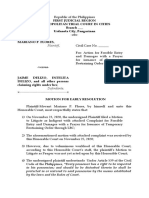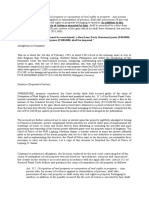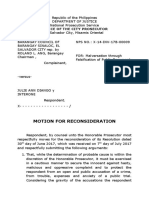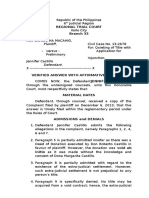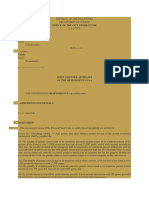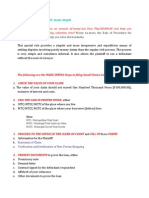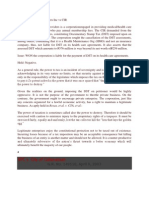Estafa
Estafa
Uploaded by
Irene QuimsonCopyright:
Available Formats
Estafa
Estafa
Uploaded by
Irene QuimsonOriginal Description:
Copyright
Available Formats
Share this document
Did you find this document useful?
Is this content inappropriate?
Copyright:
Available Formats
Estafa
Estafa
Uploaded by
Irene QuimsonCopyright:
Available Formats
Estafa; sample counter-affidavit
Below is a sample counter-affidavit prepared by Atty. Manuel J. LAserna Jr. involving Estafa undergoing preliminary investigation before an investigating prosecutor in Metro Manila. The facts part thereof are omitted. Only the jurisprudential part thereof is retained for legal research purposes of the visitors of this law blog.
REPUBLIC OF THE PHILIPPINES DEPARTMENT OF JUSTICE OFFICE OF THE CITY PROSECUTOR X x x CITY
X x x, Complainants, IS No. x x x versus Estafa X x x, Respondents. x----------------------------x
JOINT COUNTER-AFFIDAVIT OF THE RESPONDENTS X x x
THE UNDERSIGNED RESPONDENTS respectfully state:
1.
ADMISSIONS AND DENIALS.
X x x. (omitted)
2. 2.1.
DISCUSSION The relevant provisions of the Revised Penal Code on estafa (deceit/swindling) are as follows: Article 315. Swindling (estafa). Any person who shall defraud another by any of the means mentioned hereinbelow shall be punished by: 1st. The penalty of prision correccional in its maximum period to prision mayor in its minimum period, if the amount of the fraud is over 12,000 pesos but does not exceed 22,000 pesos, and if such amount exceeds the latter sum, the penalty provided in this paragraph shall be imposed in its maximum period, adding one year for each additional 10,000 pesos; but the total penalty which may be imposed shall not exceed twenty years. In such case, and in connection with the accessory penalties which may be imposed and for the purpose of other the provisions of this Code, the penalty shall be termed prision mayor or reclusion temporal, as the case may be. 2nd. The penalty of prision correccional in its minimum and medium periods, if the amount of the fraud is over 6,000 pesos but does not exceed 12,000 pesos; 3rd. The penalty of arresto mayor in its maximum period to prision correccional in its minimum period, if such amount is over 200 pesos but does not exceed 6,000 pesos; and 4th. By arresto mayor in its medium and maximum periods, if such amount does not exceed 200 pesos, provided that in the four cases mentioned, the fraud be committed by any of the following means: 1. With unfaithfulness or abuse of confidence, namely: (a) By altering the substance, quantity, or quality of anything of value which the offender shall deliver by virtue of an obligation to do so, even though such obligation be based on an immoral or illegal consideration. (b) By misappropriating or converting, to the prejudice of another, money, goods, or any other personal property received by the offender in trust or on commission, or for administration, or under any other obligation involving the duty to make delivery of or to return the same, even though such obligation be totally or partially guaranteed by a bond; or by denying having received such money, goods, or other property. (c) By taking undue advantage of the signature of the offended party in blank, and by writing any document above such signature in blank, to the prejudice of the offended party or of any third person. 2. By means of any of the following false pretenses or fraudulent acts executed prior to or simultaneously with the commission of the fraud:
(a) By using fictitious name, or falsely pretending to possess power, influence, qualifications, property, credit, agency, business or imaginary transactions, or by means of other similar deceits. (b) By altering the quality, fineness or weight of anything pertaining to his art or business. (c) By pretending to have bribed any Government employee, without prejudice to the action for calumny which the offended party may deem proper to bring against the offender. In this case, the offender shall be punished by the maximum period of the penalty. (d) By post-dating a check, or issuing a check in payment of an obligation when the offender had no funds in the bank, or his funds deposited therein were not sufficient to cover the amount of check. The failure of the drawer of the check to deposit the amount necessary to cover his check within three (3) days from receipt of notice from the bank and/or the payee or holder that said check has been dishonored for lack of insufficiency of funds shall be prima facie evidence of deceit constituting false pretense or fraudulent act. (As amended by Republic Act No. 4885, approved June 17, 1967.) (e) By obtaining any food, refreshment or accommodation at a hotel, inn, restaurant, boarding house, lodging house, or apartment house and the like without paying therefor, with intent to defraud the proprietor or manager thereof, or by obtaining credit at a hotel, inn, restaurant, boarding house, lodging house, or apartment house by the use of any false pretense, or by abandoning or surreptitiously removing any part of his baggage from a hotel, inn, restaurant, boarding house, lodging house or apartment house after obtaining credit, food, refreshment or accommodation therein without paying for his food, refreshment or accommodation. (As amended by Com. Act No. 157.) 3. Through any of the following fraudulent means: (a) By inducing another, by means of deceit, to sign any document. (b) By resorting to some fraudulent practice to insure success in a gambling game. (c) By removing, concealing or destroying, in whole or in part, any court record, office files, document or any other papers. X x x.
2.2.
In the case of DIONISIO AW a.k.a. TONY GO vs. PEOPLE OF THE PHILIPPINES, GR No. 182276, March 29, 2010, the elements of Estafa were discussed by the Supreme Court, thus:
Xxx.
The elements of Estafa under Article 315, Paragraph 1(B) of the Revised Penal Code are: (a) that money, goods or other personal property is received by the offender in trust or on commission, or for administration, or under any other obligation involving the duty to make delivery of or to return the same. (b) that there be misappropriation or conversion of such money or property by the offender, or denial on his part of such receipt (c) and (d) that such misappropriation or conversion or denial is to the prejudice of another;
there is demand by the offended party to the offender.
The first element of Estafa under Article 315, Paragraph 1(B) is the receipt by the offender of the money, goods, or other personal property in trust or on commission, or for administration, or under any other obligation involving the duty to make delivery of or to return the same. X x x. We next turn to the second element of Estafa under Article 315, Paragraph 1(B) namely, prejudice and the third element, therein of misappropriation. The essence of Estafa under Article 315, paragraph 1(b) is the appropriation or conversion of money or property received to the prejudice of the owner. The words convert and misappropriate connote an act of using or disposing of anothers property as if it were ones own, or of devoting it to a purpose or use different from that agreed upon. To misappropriate for ones own use includes not only conversion to ones personal advantage, but also every attempt to dispose of the property of another without right. X x x.
2.3.
In the case of ROSITA SY vs. PEOPLE OF THE PHILIPPINES, G.R. No. 183879, April 14, 2010 discussed the ways of committing the felony of estafa, thus:
X x x.
The sole issue for resolution is whether Sy should be held liable forestafa, penalized under Article 315, paragraph 2(a) of the Revised Penal Code (RPC).
Swindling or estafa is punishable under Article 315 of the RPC. There are three ways of committing estafa, viz.: (1) with unfaithfulness or abuse of confidence; (2) by means of false pretenses or fraudulent acts; or (3) through fraudulent means. The three ways of committing estafa may be reduced to two, i.e., (1) by means of abuse of confidence; or (2) by means of deceit. The elements of estafa in general are the following: (a) that an accused defrauded another by abuse of confidence, or by means of deceit; and (b) that damage and prejudice capable of pecuniary estimation is caused the offended party or third person. The act complained of in the instant case is penalized under Article 315, paragraph 2(a) of the RPC, wherein estafa is committed by any person who shall defraud another by false pretenses or fraudulent acts executed prior to or simultaneously with the commission of the fraud. It is committed by using fictitious name, or by pretending to possess power, influence, qualifications, property, credit, agency, business or imaginary transactions, or by means of other similar deceits. The elements of estafa by means of deceit are the following, viz.: (a) that there must be a false pretense or fraudulent representation as to his power, influence, qualifications, property, credit, agency, business or imaginary transactions; (b) that such false pretense or fraudulent representation was made or executed prior to or simultaneously with the commission of the fraud; (c) that the offended party relied on the false pretense, fraudulent act, or fraudulent means and was induced to part with his money or property; and (d) that, as a result thereof, the offended party suffered damage. X x x.
2.4.
In the case of FRANCISCO R. LLAMAS and CARMELITA C. LLAMAS vs. THE HONORABLE COURT OF APPEALS, BRANCH 66 OF THE REGIONAL TRIAL COURT OF MAKATI CITY and THE PEOPLE OF THE PHILIPPINES, GR No. 149588, August 16, 2010, it was held, among other things, that DAMAGE is an element of estafa, thus: X x x. Article 316 (2) of the Revised Penal Code states:
ART. 316. Other forms of swindling. The penalty of arresto mayor in its minimum and medium periods and a fine of not less than the value of the damage caused and not more than three times such value, shall be imposed upon: xxx 2. Any person who, knowing that real property is encumbered, shall dispose of the same, although such encumbrance be not recorded; xxx
In every criminal prosecution, the State must prove beyond reasonable doubt all the elements of the crime charged and the complicity or participation of the accused. For petitioners to be convicted of the crime of swindling under Article 316 (2) of the Revised Penal Code, the prosecution had the burden to prove the confluence of the following essential elements of the crime: 1. that the thing disposed of be real property; 2. that the offender knew that the real property was encumbered, whether the encumbrance is recorded or not; 3. that there must be express representation by the offender that the real property is free from encumbrance; and 4. that the act of disposing of the real property be made to the damage of another.
One of the essential elements of swindling under Article 316, paragraph 2, is that the act of disposing the encumbered real property is made to the damage of another. In this case, neither the trial court nor the CA made any finding of any damage to the offended party. Nowhere in the Decision of the RTC or that of the CA is there any discussion that there was damage suffered by complainant Avila, or any finding that his rights over the property were prejudiced. On the contrary, complainant had possession and control of the land even as the cases were being heard. His possession and right to exercise dominion over the property was not disturbed. Admittedly, there was delay in the delivery of the title. This, however, was the subject of a separate case, which was eventually decided in petitioners favor.
If no damage should result from the sale, no crime of estafa would have been committed by the vendor, as the element of damage would then be lacking. The inevitable conclusion, therefore, is that petitioners should be acquitted of the crime charged. X x x. (underscoring supplied) 2.5. There is no proof that the respondents intentionally, maliciously and feloniously deceived the association. Respondents x x x and x xx signed the questioned check as authorized bank signatories of the association. (Note: Respondent x x x did not sign the check. He did not participate in the questioned transactions in any manner). 2.5.1. There is no proof that the respondents damaged the association by using, malversing or converting the questioned amount to their own personal use. Respondents x x x and x x x simply transferred the amount to the name of the new Cooperative IN GOOD FAITH in accord with the formal manifestation, mandate, order, wish, and desire of the members of the association who had formed a new Cooperative and who had mandated the association to transfer its funds, assets, concessions, and contracts association to the new Cooperative. GOOD FAITH is a defense in malum en se, such as estafa. This is too basic and too elementary a doctrine that it does not require jurisprudential citations. At any rate, the following cases are cited:
2.5.2.
2.5.3.
PEOPLE OF THE PHILIPPINES vs. CORA ABELLA OJEDA, G.R. Nos. 104238-58, June 2004, on GOOD FIATH as a defense in estafa and mala en se.
X x x. DECEIT AND DAMAGE AS ELEMENTS OF ESTAFA Under paragraph 2 (d) of Article 315 of the RPC, as amended by RA 4885, the elements of estafa are: (1) a check is postdated or issued in payment of an obligation contracted at the time it is issued; (2) lack or insufficiency of funds to cover the check; (3) damage to the payee thereof. Deceit and damage are essential elements of the offense and must be established by satisfactory proof to warrant conviction. Thus, the drawer of the dishonored check is given three days from receipt
of the notice of dishonor to cover the amount of the check. Otherwise a prima facie presumption of deceit arises. The prosecution failed to prove deceit in this case. The prima faciepresumption of deceit was successfully rebutted by appellants evidence of good faith, a defense in estafa by postdating a check. Good faith may be demonstrated, for instance, by a debtors offer to arrange a payment scheme with his creditor. In this case, the debtor not only made arrangements for payment; as complainant herself categorically stated, the debtor-appellant fully paid the entire amount of the dishonored checks. It must be noted that our Revised Penal Code was enacted to penalize unlawful acts accompanied by evil intent denominated as crimes mala in se. The principal consideration is the existence of malicious intent. There is a concurrence of freedom, intelligence and intent which together make up the criminal mind behind the criminal act. Thus, to constitute a crime, the act must, generally and in most cases, be accompanied by a criminal intent.Actus non facit reum, nisi mens sit rea. No crime is committed if the mind of the person performing the act complained of is innocent. As we held in Tabuena vs. Sandiganbayan, 268 SCRA 332 [1997].: The rule was reiterated in People v. Pacana, although this case involved falsification of public documents and estafa: Ordinarily, evil intent must unite with an unlawful act for there to be a crime. Actus non facit reum, nisi mens sit rea. There can be no crime when the criminal mind is wanting.
American jurisprudence echoes the same principle. It adheres to the view that criminal intent in embezzlement is not based on technical mistakes as to the legal effect of a transaction honestly entered into, and there can be no embezzlement if the mind of the person doing the act is innocent or if there is no wrongful purpose. X x x. (underscoring supplied). By Analogy: FRANCISCO M. LECAROZ and LENLIE LECAROZ, vs.SANDIGANBAYAN and PEOPLE OF THE PHILIPPINES, G.R. No. 130872, March 25, 1999, re: PRSUMPTION OF GOOD FAITH. X x x. The rule is that any mistake on a doubtful or difficult question of law may be the basis of good faith. In Cabungcal v. Cordova,No. L-16934, 31 July, 1964, 11 SCRA 584, we
affirmed the doctrine that an erroneous interpretation of the meaning of the provisions of an ordinance by a city mayor does not amount to bad faith that would entitle an aggrieved party to damages against that official. We reiterated this principle in Mabutol v. Pascual which held that public officials may not be liable for damages in the discharge of their official functions absent any bad faith. Sanders v. Veridiano II expanded the concept by declaring that under the law on public officers, acts done in the performance of official duty are protected by the presumption of good faith. X x x.
2.5.4. 2.5.5. 2.6. 2.7.
X x x. X x x. X x x. In the case of PEOPLE OF THE PHILIPPINES vs. FELICIANO ANABE y CAPILLAN, G.R. No. 179033 , September 6, 2010, where conspiracy was not proved, the Supreme Court held, thus: X x x. While conspiracy was alleged in the Informations, it was notestablished during the trial.
Conspiracy as a basis for conviction must rest on nothing less than a moral certainty. Considering the far-reaching consequences of a criminal conspiracy, the same degree of proof necessary in establishing the crime is required to support the attendance thereof, i.e., it must be shown to exist as clearly and convincingly as the commission of the offense itself. While conspiracy need not be established by direct evidence, it is nonetheless required that it be proved by clear and convincing evidence by showing a series of acts done by each of the accused in concert and in pursuance of the common unlawful purpose. In the present case, there is want of evidence to show the concerted acts of appellant, Conrada and Felicita (albeit already discharged) in pursuing a common design to rob Uy. The prosecution in fact appears to have abandoned the theory of conspiracy altogether, no evidence thereof having been presented. Absent proof of conspiracy, appellant may only be held accountable for acts that are imputable to him with moral certainty. X x x.
2.8.
IN THE CASE OF ROSIE QUIDET VS. PEOPLE OF THE PHILIPPINES, G.R. NO. 170289, APRIL 8, 2010, IT WAS HELD, THUS:
Conspiracy must be proved as clearly and convincingly as the commission of the offense itself for it is a facile device by which an accused may be ensnared and kept within the penal fold. In case of reasonable doubt as to its existence, the balance tips in favor of the milder form of criminal liability as what is at stake is the accuseds liberty. We apply these principles in this case. X x x. Conspiracy exists when two or more persons come to an agreement concerning the commission of a felony and decide to commit it. The essence of conspiracy is the unity of action and purpose. Its elements, like the physical acts constituting the crime itself, must be proved beyond reasonable doubt. When there is conspiracy, the act of one is the act of all. Conspiracy can be inferred from and established by the acts of the accused themselves when said acts point to a joint purpose and design, concerted action and community of interests. However, in determining whether conspiracy exists, it is not sufficient that the attack be joint and simultaneous for simultaneousness does not of itself demonstrate the concurrence of will or unity of action and purpose which are the bases of the responsibility of the assailants. What is determinative is proof establishing that the accused were animated by one and the same purpose. X x x. There is no question that "a person may be convicted for the criminal act of another where, between them, there has been conspiracy or unity of purpose and intention in the commission of the crime charged." It is, likewise, settled that "to establish conspiracy, it is not necessary to prove previous agreement to commit a crime, if there is proof that the malefactors have acted in consort and in pursuance of the same objective." Nevertheless, "the evidence to prove the same must be positive and convincing. As a facile device by which an accused may be ensnared and kept within the penal fold, conspiracy requires conclusive proof if we are to maintain in full strength the substance of the timehonored principle in criminal law requiring proof beyond reasonable doubt before conviction." X x x. Moreover, although the appellant and his co-accused acted with some degree of simultaneity in attacking the deceased, nevertheless, the same is insufficient to prove conspiracy. The rule is well-settled that "simultaneousness does not of itself demonstrate the concurrence of will nor the unity of action and purpose which are the basis of the responsibility of two or more individuals." To establish common responsibility it is not sufficient that the attack be joint and simultaneous; it is necessary that the assailants be animated by one and the same purpose. In the case at bar, the appellant Raymundo Vistido and the accused Pepito Montao, did not act pursuant to the same objective. Thus, the purpose of the latter was to
kill as shown by the fact that he inflicted a mortal wound below the abdomen of the deceased which caused his death. On the other hand, the act of the appellant in giving the deceased one fist blow after the latter was stabbed by the accused Pepito Montao an act which is certainly unnecessary and not indispensable for the consummation of the criminal assault does not indicate a purpose to kill the deceased, but merely to "show off" or express his sympathy or feeling of camaraderie with the accused Pepito Montao. Thus, in People vs. Portugueza, this Court held that: X x x. By and large, the evidence for the prosecution failed to show the existence of conspiracy which, according to the settled rule, must be shown to exist as clearly and convincingly as the crime itself. In the absence of conspiracy, the liability of the defendants is separate and individual, each is liable for his own acts, the damage caused thereby, and the consequences thereof. While the evidence shows that the appellant boxed the deceased, it is, however, silent as to the extent of the injuries, in which case, the appellant should be held liable only for slight physical injuries. We reach the same conclusion here. For failure of the prosecution to prove conspiracy beyond reasonable doubt, petitioners liability is separate and individual. X x x. 2.9. 2.10. 2.11. X x x.. The respondents reserve the right to file a SUPPLEMENTAL AFFIDAVIT x x x. The respondents reserve the right to file a REJOINDER-AFFIDAVIT.
PRAYER WHEREFORE, premises considered, it is respectfully prayed that the instant criminal complaint be DISMISSED for lack of merit. Further, the respondents respectfully pray for such and other reliefs as may be deemed just and equitable in the premises. X x x City, x x x.
Xxx Respondent
xxx Respondent
Xxx Respondent
SUBSCRIBED and sworn to before me on x x x in x x x City.
Assistant City Prosecutor
You might also like
- What Is Custodial InvestigationDocument11 pagesWhat Is Custodial InvestigationIrene Quimson100% (4)
- Abuse of Confidence (Article 315, 1-B)Document3 pagesAbuse of Confidence (Article 315, 1-B)Nina PinedaNo ratings yet
- Part II Appellee S BriefDocument17 pagesPart II Appellee S BriefJoielyn Dy DimaanoNo ratings yet
- DAR A.O. No. 3-11Document8 pagesDAR A.O. No. 3-11Darren MolinaNo ratings yet
- Iper Comment On ContemptDocument4 pagesIper Comment On ContemptGerald HernandezNo ratings yet
- Accion InterdictalDocument3 pagesAccion InterdictalFLORENCIO jr LiongNo ratings yet
- Sample Aff EstafaDocument53 pagesSample Aff EstafarandeaNo ratings yet
- Sample-Affidavit Complaint-PerjuryDocument18 pagesSample-Affidavit Complaint-PerjuryDaniel Besina Jr.100% (1)
- Dennis COMPLAINTDocument4 pagesDennis COMPLAINTSonnyboy MiguelNo ratings yet
- Affidavit of LossDocument2 pagesAffidavit of LosspatrinciaNo ratings yet
- Jurisdiction CasesDocument40 pagesJurisdiction CasesR.A. GregorioNo ratings yet
- Demurrer To EvidenceDocument4 pagesDemurrer To EvidenceYanilyAnnVldzNo ratings yet
- Arias Doctrine - Magsuci CaseDocument3 pagesArias Doctrine - Magsuci CasechevroliemNo ratings yet
- Complaint in Connection For Memorandum of FactsDocument2 pagesComplaint in Connection For Memorandum of FactsMichelle Muhrie TablizoNo ratings yet
- DISBARMENT BarzaDocument20 pagesDISBARMENT BarzaJudge Florentino FloroNo ratings yet
- CORRECT FORM 2014-12-001 Rev 0 Conversion To Non-Quota Immigrant by Marriage Probationary PDFDocument3 pagesCORRECT FORM 2014-12-001 Rev 0 Conversion To Non-Quota Immigrant by Marriage Probationary PDFEric Zarriello100% (1)
- Zari Vs FloresDocument8 pagesZari Vs Floresrafaelturtle_ninjaNo ratings yet
- Complainant,: Complaint-Affidavit THE UNDERSIGNED COMPLAINANT Respectfully AllegesDocument5 pagesComplainant,: Complaint-Affidavit THE UNDERSIGNED COMPLAINANT Respectfully AllegesBeta Sigma Lambda Marawi ChapterNo ratings yet
- Salinas 1Document5 pagesSalinas 1Darwin ViadumangNo ratings yet
- Labor-Motion To Release Monetary AwardDocument111 pagesLabor-Motion To Release Monetary AwardDe La Cerna And AssociatesNo ratings yet
- Republic of The Philippines Regional Trial Court Branch 41 Baguio City People of The PhilippinesDocument4 pagesRepublic of The Philippines Regional Trial Court Branch 41 Baguio City People of The PhilippinesDashNo ratings yet
- Metropolitan Trial Court: Customer No. 000222277778888Document4 pagesMetropolitan Trial Court: Customer No. 000222277778888Rede JaurigueNo ratings yet
- Republic of The Philippines: Department of Justice National Prosecution ServiceDocument13 pagesRepublic of The Philippines: Department of Justice National Prosecution ServiceHanna EmNo ratings yet
- Versus-: Grace O. DepalingDocument1 pageVersus-: Grace O. DepalingannamariepagtabunanNo ratings yet
- Agarrado v. Agarrado - Judicial Partition in MTCDocument9 pagesAgarrado v. Agarrado - Judicial Partition in MTCMarlon TabilismaNo ratings yet
- Republic of The Philippines Office of The Ombudsman: ComplainantDocument2 pagesRepublic of The Philippines Office of The Ombudsman: ComplainantHalmen ValdezNo ratings yet
- Resolution Fiscal - KentDocument4 pagesResolution Fiscal - KentCandon City LGUNo ratings yet
- Comment-Opposition To Manifestation and Motion Laturnas Vs AbsinDocument4 pagesComment-Opposition To Manifestation and Motion Laturnas Vs AbsinDerrick de los ReyesNo ratings yet
- Motion For Early ResolutionDocument5 pagesMotion For Early ResolutionMarianoFloresNo ratings yet
- Occupation of Real Property Doctrines Sample Accusatory PortionDocument2 pagesOccupation of Real Property Doctrines Sample Accusatory PortionRyan Acosta100% (1)
- Motion To Investigate Collusion and Chnage of AddressDocument3 pagesMotion To Investigate Collusion and Chnage of AddressConcepcion CejanoNo ratings yet
- I - Crim - SB-18-CRM-0385-0387 - People Vs Cortez, Et Al - 09 - 04 - 2019 PDFDocument4 pagesI - Crim - SB-18-CRM-0385-0387 - People Vs Cortez, Et Al - 09 - 04 - 2019 PDFKin Pearly FloresNo ratings yet
- Metropolitan Trial Court Branch - ( - ) Quezon City People of The PhilippinesDocument2 pagesMetropolitan Trial Court Branch - ( - ) Quezon City People of The PhilippinesJay RibsNo ratings yet
- Regime of Complete Separation of PropertiesDocument1 pageRegime of Complete Separation of PropertiesSheryl OgocNo ratings yet
- Motion For Extension CADocument3 pagesMotion For Extension CAjason simbreNo ratings yet
- G.R. No. 1181, April 27, 1905Document3 pagesG.R. No. 1181, April 27, 1905MATANG Pilipino100% (1)
- JURATDocument1 pageJURATKinitDelfinCelestialNo ratings yet
- Motion For Reconsideration: Office of The City ProsecutorDocument8 pagesMotion For Reconsideration: Office of The City ProsecutorDanpatz Garcia100% (1)
- Brief in Opposition To Motion To Amend ComplaintDocument13 pagesBrief in Opposition To Motion To Amend ComplaintCorinne M MullenNo ratings yet
- Estafa - Complaint-Affidavit - SampleDocument4 pagesEstafa - Complaint-Affidavit - SampleKristine MagbojosNo ratings yet
- AnswerDocument6 pagesAnswerNeNe Dela LLanaNo ratings yet
- Arguments and Discussion For Cancellation of Title 2017 CaseDocument1 pageArguments and Discussion For Cancellation of Title 2017 CasePatrio Jr SeñeresNo ratings yet
- RESEARCH - Motion For InterventionDocument9 pagesRESEARCH - Motion For InterventionSherlyn Paran Paquit-SeldaNo ratings yet
- Department of Jusctice Office of The Provincial ProsecutorDocument2 pagesDepartment of Jusctice Office of The Provincial ProsecutorIan Luis AguilaNo ratings yet
- Admission Case DigestsDocument24 pagesAdmission Case DigestsRyannDeLeonNo ratings yet
- Legre PetitionDocument4 pagesLegre PetitionJavi HernanNo ratings yet
- Memorandum People V Franze RamirezDocument19 pagesMemorandum People V Franze RamirezTsi Ming TsoiNo ratings yet
- Counter AffidavitDocument2 pagesCounter Affidavitulonggwapo2No ratings yet
- Affidavit Request - HDODocument2 pagesAffidavit Request - HDOhalmen.v342No ratings yet
- Position Paper Ronquillo vs. WheeltekDocument5 pagesPosition Paper Ronquillo vs. Wheeltekviolaine wycocoNo ratings yet
- Complaint in InterventionDocument5 pagesComplaint in InterventionIone Mary GuerNo ratings yet
- Complaint AffidavitDocument2 pagesComplaint Affidavitkathykeh100% (1)
- Sps. Florentino: ComplaintDocument5 pagesSps. Florentino: ComplaintKae PorneldaNo ratings yet
- Lozada V PeopleDocument5 pagesLozada V PeopleJennyMariedeLeonNo ratings yet
- Petition (Marcial Vs Hon Lerio Castigador CA Final)Document12 pagesPetition (Marcial Vs Hon Lerio Castigador CA Final)felix reyesNo ratings yet
- Position Paper CarnappingDocument11 pagesPosition Paper CarnappingIgorot HectorNo ratings yet
- MEMO AdoptionDocument4 pagesMEMO AdoptionChristian UrbinaNo ratings yet
- Walking a Tightrope: Biography of Honorable Mayor Catalino Gabot Hermosilla Sr.From EverandWalking a Tightrope: Biography of Honorable Mayor Catalino Gabot Hermosilla Sr.No ratings yet
- Sample ComplaintDocument5 pagesSample Complaintxx_stripped52No ratings yet
- Public of The PhilippinesDocument11 pagesPublic of The PhilippinesAileen RoseNo ratings yet
- Counter Affidavit EstafaDocument9 pagesCounter Affidavit EstafaLeo LigutanNo ratings yet
- Executive DepartmentDocument8 pagesExecutive DepartmentIrene QuimsonNo ratings yet
- Promissory NoteDocument1 pagePromissory NoteIrene QuimsonNo ratings yet
- PEDRO G. SISTOZA, Petitioner, vs. ANIANO DESIERTO in His Capacity As Ombudsman, and ELISEO CO, RespondentsDocument6 pagesPEDRO G. SISTOZA, Petitioner, vs. ANIANO DESIERTO in His Capacity As Ombudsman, and ELISEO CO, RespondentsIrene QuimsonNo ratings yet
- Simultaneously With The Commission of The Fraud. Thus, Under Article 315, Paragraph 2 (D) ofDocument2 pagesSimultaneously With The Commission of The Fraud. Thus, Under Article 315, Paragraph 2 (D) ofIrene QuimsonNo ratings yet
- Second DivisionDocument10 pagesSecond DivisionIrene QuimsonNo ratings yet
- Mnemonics in Labor Laws and Social LegislationDocument108 pagesMnemonics in Labor Laws and Social LegislationdavaounionNo ratings yet
- Constructive Dismissal - 2016Document9 pagesConstructive Dismissal - 2016Irene Quimson100% (1)
- The Expanded Jurisdiction of Cam and JDRDocument5 pagesThe Expanded Jurisdiction of Cam and JDRliljoyNo ratings yet
- Salient Features of Notarial LawDocument5 pagesSalient Features of Notarial LawIrene Quimson100% (2)
- Alternative Dispute Resolution: ArbitrationDocument1 pageAlternative Dispute Resolution: ArbitrationIrene QuimsonNo ratings yet
- C. Criterion-Referenced TestDocument6 pagesC. Criterion-Referenced TestIrene QuimsonNo ratings yet
- Small Claims Case Made SimpleDocument21 pagesSmall Claims Case Made SimpleIrene QuimsonNo ratings yet
- Rule 55. Default Default Judgment: Ntering A EfaultDocument1 pageRule 55. Default Default Judgment: Ntering A EfaultIrene QuimsonNo ratings yet
- Philosophical FoundationsDocument3 pagesPhilosophical FoundationsIrene QuimsonNo ratings yet
- Obillos Et Al vs. CIR/CA: MoneyDocument2 pagesObillos Et Al vs. CIR/CA: MoneyIrene QuimsonNo ratings yet
- Verification / Certification of Non-Forum Shopping Republic of The Philippines) City of Dagupan) S.SDocument1 pageVerification / Certification of Non-Forum Shopping Republic of The Philippines) City of Dagupan) S.SIrene QuimsonNo ratings yet
- 971 - 75: Early Years: Wicked Lester Gene Simmons Paul Stanley Epic RecordsDocument3 pages971 - 75: Early Years: Wicked Lester Gene Simmons Paul Stanley Epic RecordsIrene QuimsonNo ratings yet
- Xvii. Special Civil ActionsDocument2 pagesXvii. Special Civil ActionsIrene QuimsonNo ratings yet
- This Article Is About The American Rock Band. For The South Korean Group, SeeDocument3 pagesThis Article Is About The American Rock Band. For The South Korean Group, SeeIrene QuimsonNo ratings yet
- NPC v. City of Cabanatuan: G.R. No. 149110, April 9, 2003Document3 pagesNPC v. City of Cabanatuan: G.R. No. 149110, April 9, 2003Irene QuimsonNo ratings yet
- Examples From The Web For Kissexpand: Keep It Simple, StupidDocument1 pageExamples From The Web For Kissexpand: Keep It Simple, StupidIrene QuimsonNo ratings yet
- 1975 - 78: Rise To Prominence: Alive!Document2 pages1975 - 78: Rise To Prominence: Alive!Irene QuimsonNo ratings yet
- IDocument5 pagesIIrene Quimson100% (6)




























